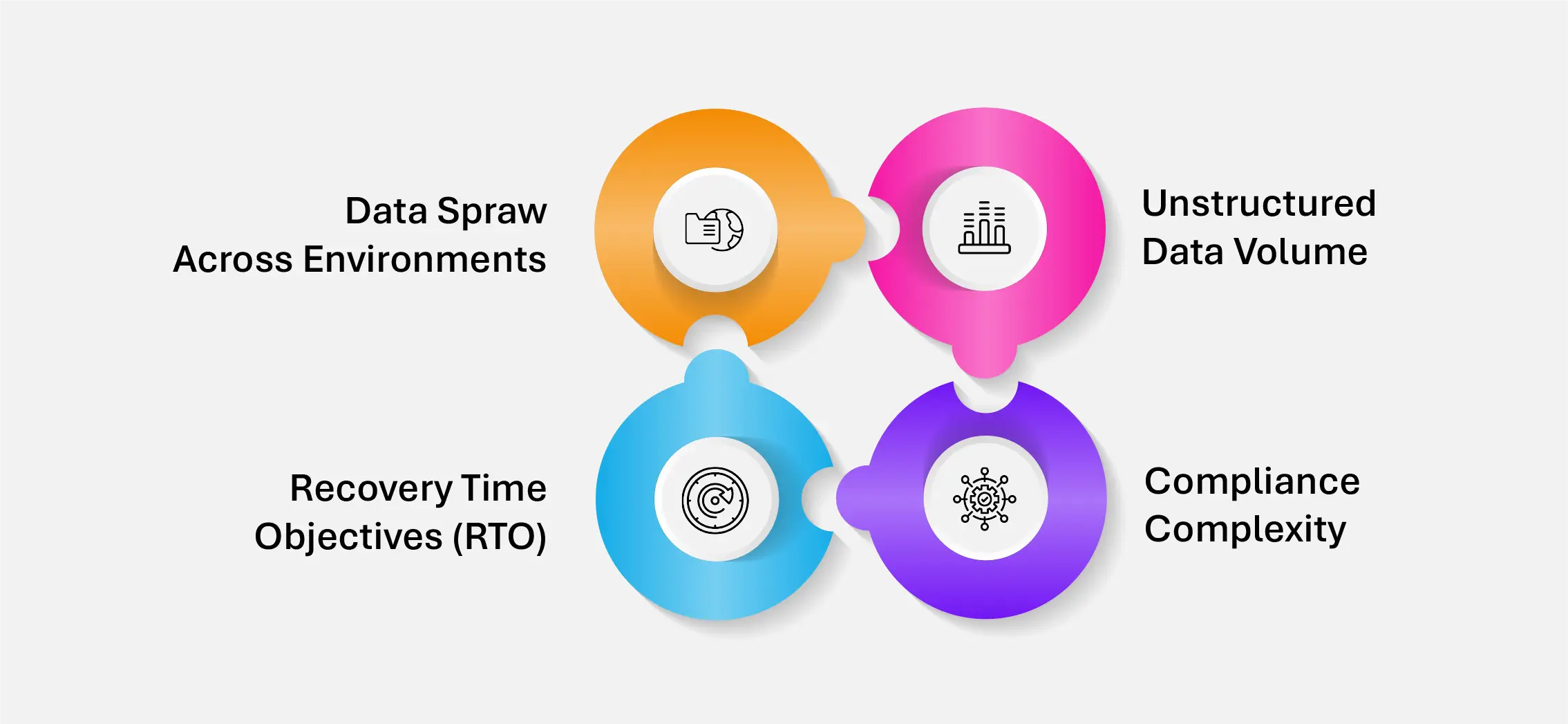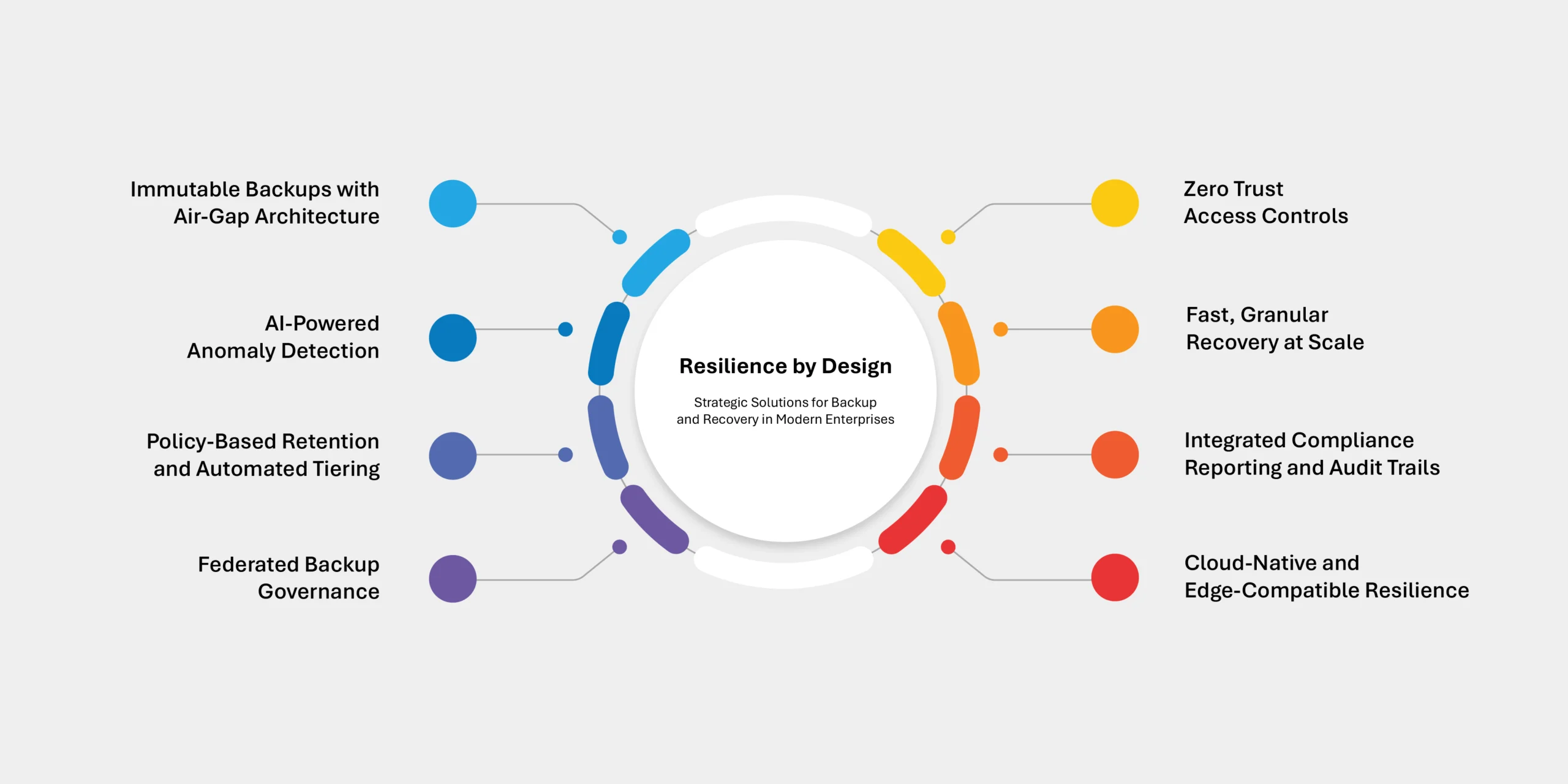What is Data Backup and Recovery?
Data Backup and Recovery refer to the processes and technologies used to create secure copies of data and restore them in the event of loss, corruption, deletion, or disaster. While backups ensure a retrievable version of data exists, recovery is the act of restoring that data to its original or functional state, whether due to cyberattacks, system failures, accidental deletions, or regulatory mandates.
Why It Matters in Today’s Enterprise
In a world where data is the backbone of every digital operation, backup and recovery aren’t just operational safeguards—they’re business-critical functions. With the rise in ransomware, system outages, and regulatory requirements around data retention, having a resilient backup and fast, auditable recovery process is no longer optional. It’s a foundational element of cyber resilience, compliance, and business continuity.
Beyond Traditional Backups: The Modern Shift
Legacy backup systems were typically designed for periodic, volume-based snapshots, often stored on-prem or in cold storage. But today’s dynamic enterprise environments—especially those powered by hybrid cloud, containers, and edge systems—require real-time, policy-driven, and scalable backup strategies.
Modern backup and recovery solutions leverage:
- AI/ML-based anomaly detection to identify unusual data changes (e.g., ransomware activity)
- Immutable backups that cannot be altered or deleted even by internal users
- Granular, metadata-aware recovery that allows restoring individual files, applications, or datasets
- Cloud-native backups that are location-aware and compliant with regional data residency laws
Key Challenges

- Data Sprawl Across Environments: Multiple clouds, edge locations, and legacy systems complicate centralized backup management.
- Unstructured Data Volume: Backing up petabytes of unstructured, siloed data without indexing can lead to costly inefficiencies and restore delays.
- Compliance Complexity: Backup policies must now consider retention limits, encryption mandates, and cross-border data handling rules.
- Recovery Time Objectives (RTO): As SLAs tighten, businesses need near-instant recovery—not hours or days.
Resilience by Design: Strategic Solutions for Backup and Recovery in Modern Enterprises

- Immutable Backups with Air-Gap Architecture: Ensure critical data is stored in tamper-proof, write-once-read-many (WORM) formats, separated from production environments to resist ransomware and insider threats.
- AI-Powered Anomaly Detection: Use machine learning to monitor backup behavior and detect suspicious patterns—such as encryption spikes or abnormal deletion requests—early in the attack lifecycle.
- Policy-Based Retention and Automated Tiering: Align backup retention policies with regulatory and business needs using intelligent automation to archive, tier, and delete data based on usage, risk, and compliance profiles.
- Federated Backup Governance: Implement a unified policy framework to manage backup and recovery across multi-cloud, hybrid, and edge environments, ensuring consistency and control enterprise-wide.
- Zero Trust Access Controls: Integrate backup workflows with RBAC, MFA, and least-privilege access to prevent unauthorized recovery, deletion, or manipulation of backup data.
- Fast, Granular Recovery at Scale: Enable point-in-time recovery of files, objects, or entire environments with minimal downtime—supported by snapshot orchestration, replication, and data mobility features.
- Integrated Compliance Reporting and Audit Trails: Maintain continuous auditability with real-time logging, immutable audit trails, and compliance dashboards aligned with GDPR, HIPAA, DPDP, and other global mandates.
- Cloud-Native and Edge-Compatible Resilience: Design backups for cloud elasticity and edge-specific latency constraints, enabling fast, localized recovery in low-connectivity or remote scenarios.
Redefining Continuity: The Strategic Nexus of AI, Compliance, and Cyber Resilience
Backup and recovery is no longer just a failsafe—it’s foundational to enterprise-wide AI readiness, regulatory compliance, and cybersecurity resilience. In AI-driven ecosystems, model performance hinges on historical data integrity. Without assured, accessible, and uncorrupted backups, retraining algorithms or recovering from data drift becomes nearly impossible.
From a compliance lens, regulations like GDPR, HIPAA, and India’s DPDP Act require not only retention and erasure but proof of recoverability and audit trails. In this climate, backup strategies must integrate with data governance frameworks, supporting traceability, classification, and right-to-erasure functionality.
Cybersecurity threats have also redefined the stakes. Ransomware, wiper malware, and zero-day exploits target data at rest, in transit, and in backup. As a result, backup systems must now be secure-by-design: encrypted, immutable, segmented from production, and fortified with AI-powered threat detection.
Enterprises that treat backup and recovery as a strategic lever—not just a disaster response—position themselves to lead with trust, agility, and operational confidence in an increasingly volatile digital landscape.
The Future of Backup and Recovery
Tomorrow’s backup systems will be autonomous, context-aware, and risk-driven. Instead of treating all data equally, they’ll prioritize what matters most—backing up sensitive, frequently accessed, or compliance-heavy datasets proactively. Recovery will become smart and predictive, using AI to simulate failovers, detect vulnerabilities, and even suggest backup policies before an incident occurs.
In this future, backup and recovery won’t just be part of IT’s checklist. It will be a strategic pillar of enterprise resilience—ensuring not just survival, but continuity, trust, and competitive advantage in an always-on, always-vulnerable digital world.
Getting Started with Data Dynamics:
- Learn about Unstructured Data Management
- Schedule a demo with our team
- Read the latest blog: Does Data Localization Alone Guarantee Privacy? The Unspoken Challenges






